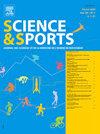限制血流结合阻力训练对激活后增强的影响:一项荟萃分析
IF 0.8
4区 医学
Q4 SPORT SCIENCES
引用次数: 0
摘要
背景与目的后激活增强(post -activation potentiation, PAP)是指爆发力在短时间内的提高,但需要通过高强度的抗阻训练来诱导。有报道称,限制血流结合低强度阻力训练(BFR-RT)对骨骼肌的影响与高强度阻力训练相似。然而,关于BFR-RT诱导PAP的研究数量有限。因此,本研究通过汇总相关研究,探讨BFR-RT对PAP的影响。检索NewsPubMed、Web of Science、ScienceDirect、Scopus、EBSCO和CNKI(中文数据库),从建库之日起至2022年9月20日,检索BFR-RT对PAP影响的随机对照试验(RCT)。对结果的影响用标准化平均差(SMD)和95%置信区间(CI)表示。Revman5.4软件纳入13篇文章,共51项研究,195名受试者进行meta分析。与对照组相比,BFR-RT显著改善了跳高(JH) (SMD = 0.49, 95%CI[0.31, 0.66])、输出功率(PO) (SMD = 0.49, 95%CI[0.30, 0.68])、发力率(RFD) (SMD = 0.60, 95%CI[0.32, 0.88])、反应性强度指数(RSI) (SMD = 0.46, 95%CI[0.02, 0.90])。动脉闭塞压(AOP)≥60%达到最大效果(SMD = 0.66, 95%CI[0.48, 0.83]),具有统计学意义。阻力训练强度≤30% 1次重复最大值(1RM)达到最大效果(SMD = 0.54, 95%CI[0.38, 0.71]),且具有统计学意义。结论本荟萃分析发现BFR-RT可诱导PAP。此外,60% ~ 80% AOP和20% ~ 30% 1RM的组合可以诱导更大的PAP。背景与客观:激活后电位(PAP) fait racry ry ry ry ry ry ry ry ry ry ry ry ry ry ry ry ry ry ry ry ry ry ry ry ry ry ry ry ry ry ry ry ry。3 .如果将本文章由计算机程序翻译,如有差异,请以英文原文为准。
The effects of blood flow restriction combined with resistance training on post-activation potentiation: A meta-analysis
Background and objective
Post-activation potentiation (PAP) refers to the improvement of explosive power in a short period of time, but it needs to be induced by high-intensity resistance training. It has been reported that blood flow restriction combined with low-intensity resistance training (BFR-RT) can produce similar effects on skeletal muscle as high-intensity resistance training. However, the number of studies on the induction of PAP by BFR-RT is limited. Therefore, this study explored the effect of BFR-RT on PAP by pooling relevant studies.
News
PubMed, Web of Science, ScienceDirect, Scopus, EBSCO, and CNKI (Chinese database) were searched for randomized controlled trial (RCT) of the effect of BFR-RT on PAP from the time of database construction until September 20, 2022. The effects on outcomes were expressed as standardized mean difference (SMD) along with 95% confidence intervals (CI). Thirteen articles with a total of 51 studies and 195 subjects were included in the Revman5.4 software for meta-analysis. BFR-RT significantly improves jump height (JH) (SMD = 0.49, 95%CI [0.31, 0.66]), power output (PO) (SMD = 0.49, 95%CI [0.30, 0.68]), rate of force development (RFD) (SMD = 0.60, 95%CI [0.32, 0.88]), reactive strength index (RSI) (SMD = 0.46, 95% CI [0.02, 0.90]) compared to the control group. Arterial occlusion pressure (AOP) ≥ 60% reached maximum effect (SMD = 0.66, 95%CI [0.48, 0.83]) and was statistically significant. Resistance training intensity ≤ 30% 1 – repetition maximum (1RM) reached the maximum effect (SMD = 0.54, 95%CI [0.38, 0.71]) and was statistically significant.
Conclusion
This meta-analysis found that BFR-RT could induce PAP. In addition, a combination of 60% ∼ 80% AOP and 20% ∼ 30% 1RM could induce greater PAP.
Contexte et objectif
La potentialisation post-activation (PAP) fait référence à l’amélioration de la puissance explosive sur une courte période, mais elle doit être induite par un entraînement de résistance de haute intensité. Il a été rapporté que la restriction du flux sanguin combinée à un entraînement de résistance de faible intensité (BFR-RT) peut produire des effets similaires sur le muscle squelettique à ceux d’un entraînement de résistance de forte intensité. Cependant, le nombre d’études sur l’induction de la PAP par l’entraînement de résistance de faible intensité est limité. Par conséquent, cette étude a exploré l’effet de la BFR-RT sur la PAP en regroupant les études pertinentes.
Nouvelles
PubMed, Web of Science, ScienceDirect, Scopus, EBSCO et CNKI (base de données chinoise) ont fait l’objet d’une recherche d’essais contrôlés randomisés (RCT) portant sur l’effet du BFR-RT sur la PAP, depuis la création de la base de données jusqu’au 20 septembre 2022. Les effets sur les résultats ont été exprimés sous forme de différence moyenne standardisée (SMD) et d’intervalles de confiance (IC) à 95 %. Treize articles avec un total de 51 études et 195 sujets ont été inclus dans le logiciel Revman5.4 pour la méta-analyse. Le BFR-RT améliore significativement la hauteur de saut (JH) (SMD = 0,49, 95 %IC [0,31, 0,66]), la puissance de sortie (PO) (SMD = 0,49, 95 %IC [0,30, 0,68]), le taux de développement de la force (RFD) (SMD = 0,60, 95 %IC [0,32, 0,88]), l’indice de force réactive (RSI) (SMD = 0,46, 95 %IC [0,02, 0,90]) par rapport au groupe de contrôle. La pression d’occlusion artérielle (AOP) ≥ 60 % a atteint un effet maximal (SMD = 0,66, 95 %IC [0,48, 0,83]) et était statistiquement significative. L’intensité de l’entraînement en résistance ≤ 30 % 1 – répétition maximale (1RM) a atteint l’effet maximal (SMD = 0,54, 95 %IC [0,38, 0,71]) et était statistiquement significative.
Conclusion
Cette méta-analyse a révélé que le BFR-RT pouvait induire une PAP. En outre, une combinaison de 60 % ∼ 80 % AOP et 20 % ∼ 30 % 1RM pourrait induire une PAP plus importante.
求助全文
通过发布文献求助,成功后即可免费获取论文全文。
去求助
来源期刊

Science & Sports
社会科学-运动科学
CiteScore
1.50
自引率
18.20%
发文量
143
审稿时长
19.7 weeks
期刊介绍:
Science & Sports is a peer-reviewed journal, publishing worldwide high-quality and impactful papers of medical, scientific and applied technical research in the different fields of sports and physical activities: sport medicine, exercise physiology, sport physiology and performance, nutrition, traumatology relating to sport, rehabilitation or adapted physical activities. It facilitates the transfer of knowledge and technology between the clinic, research and practice in physical and athletic activity.
 求助内容:
求助内容: 应助结果提醒方式:
应助结果提醒方式:


